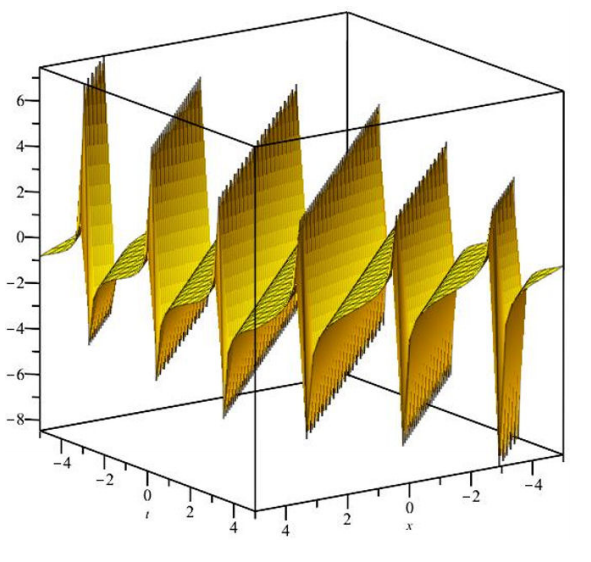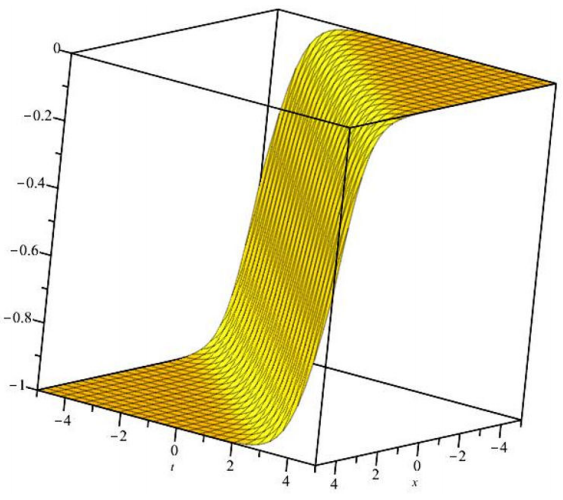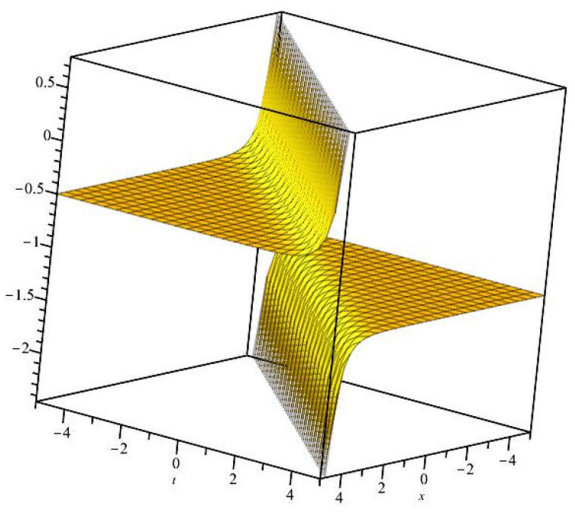Research
Gravitation, Mathematical Physics and Field Theory
Soliton solutions for Fokas-Lenells equation by (G’/G)-expansion method
aDepartment of Applied Mathematics, Faculty of Mathematical Sciences, University of Mazandaran, Babolsar, Iran.
Abstract
In this paper we investigate the Fokas-Lenells equation via the (G’/G)-expansion method. To convert this nonlinear model into ODEs, we utilize an intelligible wave transformation. The solutions show that considered method fit well for Fokas-Lenells equation with complex structure. With the view of the results, new improvements can happen for applications of the model.
Keywords: Fokas-Lenells (FL) equation; (G’/G)-expansion method; soliton
1 Introduction
One of the main nonlinear problem is the Fokas-Lenells (FL) equation
iqt+a1qxx+a2qxt+|q|2(bq+iσqx)=i(αqx+γ|q|2nq)x+η|q|2nxq).
(1)
Where a
1 and a
2 are coefficients of group velocity dispersion, this model is the famous one which constructed as applications for current-fed string interacting with an external magnetic field. The perturbation terms η,γ,α, and on the right-hand side of Eq. (1) represent nonlinear dispersion, self-steepening effect, and, self-steepening effect, and inter-modal dispersion, respectively. There have been numerous approaches put forward by several authors to handle the approximate and exact solutions these nonlinear problems which are G’/G-expansion method, direct algebraic method, Sine-cosine method, tanh method, F-expansion method, and so on [1-15]. To construct the analytical solutions of these equations for realized the dynamics structure is the mainly suitable way [16-18]. The exact solution in explicit form of these models assist the confirmation of numerical researchers and also help in investigate the stability. The purpose of this work is to apply the G’/G-expansion method to solve the Fokas-Lenells (FL) equation . Such a study has not been considered before to our knowledge. This paper is outlined as follows: Section 2 gives a brief review of (G’/G)-expansion method. Section 3 contains the discussions. Finally, conclusion is given in Sec. 4. This paper is organized as follows: In Sec. 2, we describe the (G’/G)-expansion method while the application of the method has been presented in Sec. 3. The conclusions are drawn in Sec. 4.
2 Brief of the methodology
In this section, we briefly explain the application of (G’/G)-expansion to determine an exact solution for the partial differential equation. For given NLEEs of the form
P(u,ux,ut,uxx,uxt,utt,…)=0
(2)
Consider the wave transformation, u(x,t)=U(ξ), ξ=x-vt, Eq. (2) can be reduced to the following ODE:
P(U,U',-vU',U'',-vU'',vU'',…)=0,
(3)
Where U=U(ξ), and its total derivatives. the exact solution for the nonlinear ordinary differential equation can be written in the following:
uξ=∑n=1mαnG'ξGξnα0, αm≠0
(4)
where Gξ satisfies a second order linear ordinary differential equation:
+d2Gξdξ2+λdG(ξ)dξ+μG(ξ)=0
(5)
And αn,n=0,1,2,…,m, are constants to be determined later.
Using the solutions of Eq. (5), we obtain
G'(ξ)G(ξ)=λ2-4μ2C1sinhλ2-4μ2ξ+C2coshλ2-4μ2ξC1coshλ2-4μ2ξ+C2sinhλ2-4μ2ξ-λ2, λ2-4μ>0 ,4μ-λ22-C1sinh4μ-λ22ξ+C2cosh4μ-λ22ξC1cosh4μ-λ22ξ+C2sinh4μ-λ22ξ-λ2, λ2-4μ<0 ,
(6)
and from (4) and (5), we have
U'=-∑n=1mnαnG'Gn+1+λG'Gn+μG'Gn-1
U''=∑n=1mnαn[n+1]G'Gn+2+[2n+1]λG'Gn+1+n[λ2+2μ]G'Gn+[2n-1]λμG'Gn-1+[n-1]μ2μ2G'Gn-2
Therefore, here the prime denotes the derivative with respective to ξ.
3 Discussions
Let us use the transformation
q(x,t)=u(ξ)eiϕ(ξ)-Ωt,
(7)
where u(ξ) and ϕ(ξ) are real functions of the traveling coordinate ξ=x-vt. Here, v is the group velocity while Ω is the frequency of the wave oscillation.
Substituting the transformation (7) into Eq. (1), Thus we can easily get,
-(α+v+a2Ω)u'+2(a1-a2v)u'ϕ'+(a1-a2v)uϕ''+σu2u'-([2n+1]γ+2nη)u2nu'=0
(8)
(α+v+a2Ω)uϕ'+Ωu+u''-(a1-a2v)uϕ2'+bu3-σu3ϕ'+γu2n+1ϕ'=0
(9)
Equation (9) can be integrated after multiplying on u to induce
ϕ'=α+v+a2Ω2(a1-a2v)-σu4(a1-a2v)+(2n+1γ+2nη)(a1-a2v)(2n+2),
(10)
where the integration constant is taken to be zero. We set n = 1. Therefore, Eq. (9) reduces to
ϕ'=α+v+a2Ω2(a1-a2v)+(3γ+2η-σ)u24(a1-a2v).
(11)
Thus we can easily obtain,
δω(x,t)=-α+v+a2Ω2(a1-a2v)-(3γ+2η-σ)u24(a1-a2v)
(12)
Now, substituting Eq. (12) into Eq. (8) leads to
u''+s24u+s42u+s616u5=0
(13)
where
s2=(α+v+a2Ω)2+4Ω(a1-a2v)(a1-a2v)2,
(14)
s4=γ-σα+v+a2Ω+2ba1-a2va1-a2v2
(15)
s6=3γ+2μ-σγ-2η-3σa1-a2v2
(16)
According to Step 1, we put 5m = m + 2, hence m = 1. Therefore, we assume that the solution of Eq. (13) can be expressed by a polynomial in (G’/G) as follows:
u=α1G'G+α0,α1≠0.
(17)
Substituting Eq. (14) into Eq. (13) and collecting all terms with the same order of (G’/G) together , the left-hand side of Eq. (13) is conserved into a polynomial in (G’/G). Equating each coefficient of this polynomial to zero yields a set of simultaneous algebraic equations for λ, μ, ω, α0, α1, and α2. Solving the system of algebraic equations with the aid of Maple 16, we obtain the following three general results.
Case 1.
The first set of obtained results is
v=∓23s2-12λ2, μ=±23s2, α0=0, α1=3s2.
(18)
Where λ is an arbitrary constant. Therefore, substituting the above case in Eq. (17), we get solution of Eq. (1) for λ-4μ>0,
q1(x,t)=3s2 λ-4μ2×C1sinhλ-4μ2x-∓23s2-12λ2t-C2coshλ-4μ2x-∓23s2-12λ2tC1coshλ-4μ2x-∓23s2-12λ2t+C2sinhλ-4μ2x-∓23s2-12λ2t-λ2×ei(ϕ[x-{∓(2/3)s2-(1/2)λ2}t]-Ωt)
And for λ-4μ<0
q2(x,t)=3s2 4μ-λ22×-C1sin4μ-λ22x-∓23s2-12λ2t+C2cos4μ-λ22x-∓23s2-12λ2tC1cos4μ-λ22x-∓23s2-12λ2t+C2sin4μ-λ22x-∓23s2-12λ2tλ2×ei(ϕ[x-{∓(2/3)s2-(1/2)λ2}t]-Ωt)
The second set of obtained results is
v=∓23s4-12λ2,μ=±s4,α0=23s6,α1=3s4,
we get solution of Eq. (1) for λ2-4μ>0
q1x,t=3s4 λ2-4μ2×C1sinhλ2-4μ2x-∓23s4-λ2t+C2coshλ2-4μ2x-∓23s4-λ2tC1coshλ2-4μ2x-∓23s4-λ2t+C2sinhλ2-4μ2x-∓23s4-λ2t-λ2×eiϕx-∓23s4-12λ2t-Ωt+23s6 ,
And for 4μ-λ<0
q2x,t=3s2 4μ-λ22×-C1sin4μ-λ22x-∓23s4-λ2t+C2cos4μ-λ22x-∓23s4-λ2tC1cos4μ-λ22x-∓23s4-λ2t+C2sin4μ-λ22x-∓23s4-λ2t-λ2×eiϕx-∓23s4-12λ2t-Ωt+23s6 ,
4 Conclusions
In this paper, we investigated the Fokas-Lenells equation via the G’/G- Expansion method. Using some wave transformations, the PDE system is turned into an ODE system. The solutions of the ODE system are assumed in the forms of the G’/G- Expansion method. In the same vein and parallel the FL has been applied to achieve other new visions to the soliton solutions of this model Figs, 1-3. The solutions will be considered for the new application areas of the generalized form of modified NSE. Consequently a positive forward future studies have been introduced for the given model. We also conclude that the effectively, powerful of the suggested method.
References
[1] T.B. Benjamin, J.E. Feir, The disintegration of wave trains on deep water, J. Fluid Mech. 27 (1967) 417.
[ Links ]
[2] M. Arshad, A.R. Seadawy, Dianchen Lu, Modulation stability and optical soliton solutions of nonlinear Schrödinger equation with higher order dispersion and nonlinear terms and its applications, Superlattices and Microstructures 112 (2017) 422.
[ Links ]
[3] Dianchen Lu, A.R. Seadawy, M. Arshad, Jun Wang, New solitary wave solutions of (3 + 1)-dimensional nonlinear extended Zakharov-Kuznetsov and modified KdV-Zakharov-Kuznetsov equations and their applications, Results in Physics, 7 (2017) 899.
[ Links ]
[4] M.S. Osman, J.A.T. Machado, D. Baleanu, On nonautonomous complex wave solutions described by the coupled Schrdinger-Boussinesq equation with variablecoefficients, Opt. Quant. Electron. 50 (2018) 73.
[ Links ]
[5] H.I. Abdel-Gawad , M. Tantawy, M.S. Osman, Dynamic of DNA’s possible impact on its damage, Math. Methods Appl. Sci. 39 (2016) 168.
[ Links ]
[6] M. Arshad, A.R. Seadawy, D. Lu, Exact bright-dark solitary wave solutions of the higher-order cubicquintic nonlinear Schrödinger equation and its stability, Optik, 128 (2017) 40.
[ Links ]
[7] I. Ahmed, A.R. Seadawy, D. Lu, M-shaped rational solitons and their interaction with kink waves in the Fokas-lenells equation, Physica Scripta 94 (5) (2019).
[ Links ]
[8] Y. Gurefe, E. Misirli, A. Sonmezoglu, M. Ekici, Extended trial equation method to generalized nonlinear partial differential equations, Appl. Math. Comput. 219 (2013) 5253.
[ Links ]
[9] A. Biswas, Chirp-free bright optical soliton perturbation with FokasLenells equation by traveling wave hypothesis and semi-inverse variational principle, Optik 170 (2018) 431.
[ Links ]
[10] X. Lü, F. Lin, Soliton excitations and shape-changing collisions in alpha helical proteins with interspine coupling at higher order, Commun Nonlinear Sci Numer Simulat, 32 (2016) 241.
[ Links ]
[11] M. Arshad, A.R. Seadawy, Dianchen Lu, Optical soliton solutions of the generalized higher-order nonlinear Schrödinger equations and their applications, Opt Quant Electron, 49 (2017) 421.
[ Links ]
[12] K.A. Gorshkov, L.A. Ostrovsky, Interactions of solitons in nonintegrable systems: direct perturbation method and applications, Phys D 3 (1981) 428.
[ Links ]
[13] V.I. Karpman, V.V. Solovev, A perturbation theory for soliton systems, Phys D 3 (1981) 142.
[ Links ]
[14] S. Zhang, J.L. Tong, W. Wang, A generalized G’/G-expansion method for the mKdV equation with variable coefficients. Phys. Lett. A. 372 (2008) 2254.
[ Links ]
[15] H. Zhang: New application of the G’/G-expansion method. Commun. Nonlinear Sci. Numer. Simul. 14 (2009) 3220.
[ Links ]
[16] H. Rezazadeh, A. Kurt, A. Tozar, O. Tasbozan, SM Mirhosseini-Alizamini ,Wave Behaviors of Kundu-Mukherjee-Naskar Model Arising In Optical Fiber Communication Systems with Complex Structure, Optical and Quantum Electronics 53 (2021) 317.
[ Links ]
[17] H. Rezazadeh, W. Adel, E. Tala-Tebue, S.W. Yao, M. Inc, Bright and singular soliton solutions to the Atangana-Baleanu fractional system of equations for the ISALWs, Journal of King Saud University - Science 33 (2021) 101420.
[ Links ]
[18] A. Zafar, A. Bekir, B. Khalid, H. Rezazadeh, Abundant solitary wave solutions for the fractional coupled Jaulent-Miodek equations arising in applied physics , International Journal of Modern Physics B 2050279.
[ Links ]











 text new page (beta)
text new page (beta)





